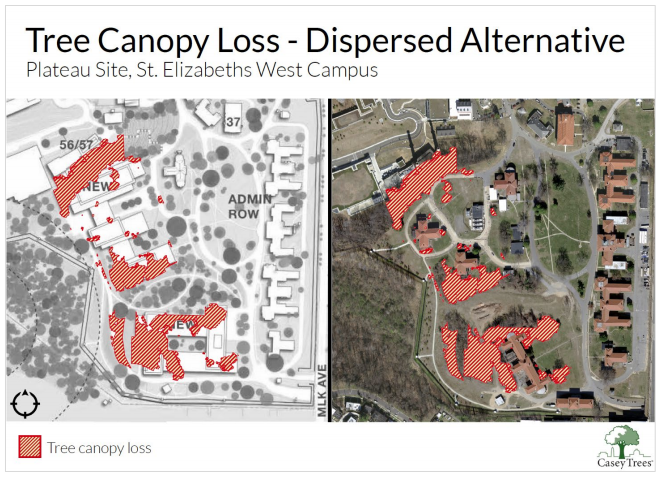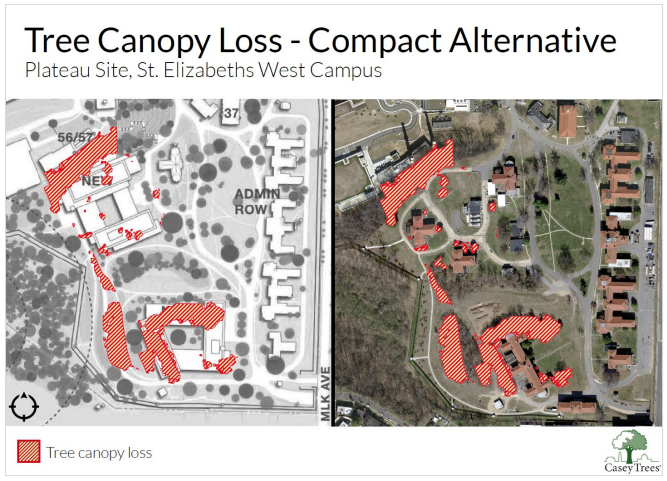St. Elizabeths West Public Comments
December 18, 2018
Paul Gyamfi
Senior NEPA Compliance Specialist
U.S. General Services Administration
National Capital Region
301 7th Street SW, Room 4004
Washington, DC 20407
Re: Master Plan #2 for the Department of Homeland Security (DHS) Headquarters Consolidation at St.Elizabeths
Dear Paul Gyamfi,
Casey Trees is a Washington, D.C.-based nonprofit, with a mission “to restore, enhance, and protect the
tree canopy of the nation’s capital.” To fulfill this mission, we plant trees; monitor the city’s tree canopy;
and work with government officials, developers, and residents to prioritize the District’s trees. We are
dedicated to helping D.C. reach its 40 percent tree canopy goal by 2032. As a city, we will achieve this
goal when development projects and city plans ensure no net loss in tree canopy. Thank you for the
opportunity to provide comments on the revised master plan for the Department of Homeland Security
(DHS) headquarters consolidation at St. Elizabeths west campus.
At the public scoping meeting on November 29, 2018, The U.S. General Services Administration (GSA)
presented two alternative plans for the plateau site development. Tree canopy covers nearly 6 acres or
35% of the plateau site. Therefore, Casey Trees’ recommendations focus on the two alternative
redevelopment plans for the plateau – the “Dispersed” plan, and the “Compact” plan.
After reviewing each alternative in detail, we urge the U.S. General Services Administration (GSA) to select
the Compact plan and to adopt the recommendations below:
1. Select the Compact plan to preserve as many existing trees as possible. If the Dispersed plan is
selected, 71% of the existing tree canopy on the plateau site would be lost, while the Compact
plan would require removal of 62% of this existing tree canopy (Figure 1).
2. Plant new trees to replace the 3.6 acres of tree canopy lost to development. Although the
Compact plan will allow the development team to preserve more trees than the Dispersed plan,
the Compact plan will still necessitate the removal of 3.6 acres – over 14,500 m2 – of existing tree
canopy. We strongly urge the development team to plant new trees to replace this lost canopy.
The 4.6 acres of green space highlighted in Figure 2 provides ample space to plant these
replacement trees. This action also complies with policy FE.G.2 of the Federal Comprehensive
Plan, which states “when tree removal is necessary, trees should be replaced to prevent a net tree
loss to the project area.” Specifically, smaller trees with a 10-inch diameter or less must be
replaced at a minimum of a one-to-one basis. Larger trees with a diameter greater than 10 inches
must be replaced at a rate derived from a formula developed by the International Society of
Arboriculture.”
3. Include a tree planting plan for the plateau site in the revised master plan. Specify where
replacement trees will be planted and what tree species will be selected. Strive to plant large
canopy trees and increase tree diversity where possible.
With the consolidation of DHS headquarters, GSA has a rare opportunity to re-envision St. Elizabeths west
campus. Taking the actions outlined above will allow GSA to maintain a 35% tree canopy while creating a
lush, green attraction that will benefit visitors and commuters; help the city reach its environmental
goals; and support a more connected citywide ecosystem.
Casey Trees would be happy to work with you on a tree planting plan or to provide tree-related analyses
for the revised master plan. If you have any questions about these recommendations, please feel free to
contact me at ktaddei@caseytrees.org.
Sincerely,
Kristin Taddei
Planning Advocate

Casey Trees recommends that the U.S. General Services Administration Select the Compact plan to preserve as many existing trees as possible at the Department of Homeland Security (DHS) headquarters consolidation at St. Elizabeths west campus.

Figure 2. If the Compact plan is selected, 62% of the existing tree canopy on the plateau site would be
removed.

Figure 3. The 4.6 acres of green space shown in green provides ample space to plant replacement trees.